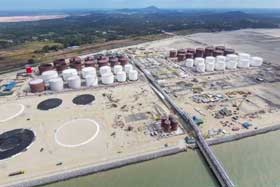Malaysia’s Pengerang oil/gas project faces challenges in difficult times

The multi-billion ringgit oil/gas and petrochemicals hub in Pengerang, Johor, Malaysia, known as the Pengerang Integrated Petroleum Complex (PIPC), is struggling to secure investors for planned phases due to the plummeting oil prices, according to reports in the local news.
Johor Petroleum Development Corp Bhd (JPDC)’s CEO Mohd Yazid Ja’af was quoted as saying that “investors are holding back their investments.” He also said that it was difficult to find a company akin to the country’s oil/petrochemicals giant Petronas (Petroliam Nasional Bhd) to invest more than RM100 billion in the project.
"We do face difficulty in attracting new investors. A lot of these integrated players are looking back at their investment plans to weather the storm and they have decided to hold back their decisions.”
He is also quoted as having said that the overall completion date of PIPC will be “slightly delayed”. The project, consisting of four phases, was earlier earmarked for completion in 2035.
However, Yazid said that the first phase is expected to be fully completed by 2019.
The PIPC is one big step in creating value to the downstream oil and gas value chain in the southern state of Johor. Sited in Pengerang, it is one of the largest pieces of investments in Pengerang district and located on a single plot measuring about 20,000 acres. The project will house oil refineries, naphtha crackers, petrochemical plants as well as a liquefied natural gas (LNG) import terminal and a regasification plant.
As of January 2013, two major catalytic projects have been committed within the PIPC area. The RM5 billion Pengerang Independent Deepwater Petroleum Terminal (PIDPT) is a joint-venture between Dialog Group of Malaysia, Royal Vopak of Netherlands and the Johor state. Construction of Phase 1 of the project was scheduled for completion by Q1 2014 as stated on the JPDC website. The total storage capacity available at PIDPT is planned for 5 million cu m by the year 2020.
The second mega-project within PIPC is Petronas’s RM60 billion Refinery and Petrochemical Integrated Development (RAPID) Project. It will have a 300,000 barrels/day refining capacity while additional petrochemical plants will generate value to petroleum products produced in RAPID, says JPDC.
In terms of production of petrochemicals, Petronas, Malaysia’s only Fortune 500 company, has already signed letters of intents in 2013 with Italy’s Versalis, Japan’s Itochu and Bangkok-listed PTT Global Chemical to build speciality chemical plants. Germany’s Evonik Industries also stepped in to the project after compatriot BASF pulled out. See more at: http://www.plasticsandrubberasia.com/apr2014/company2.html and http://www.plasticsandrubberasia.com/jan2013/company24.html
However, early this year a leaked report said that Petronas is planning to cut RM50 billion from its operating expenditure (opex) and capital expenditures (capex) and defer some of its projects. The company has been on cost cutting measures since 2014 when it was projected that the oil price decline would be around for a while.
Other major players such as BP, Royal Dutch Shell, Chevron, Norway’s Statoil and Australia’s Woodside Petroleum have collectively shelved some US$200 billion of their planned capex.
Due to this scenario, Yazid said the masterplan for PIPC, which was finalised in 2010 at the height of oil prices, would be reviewed, adding that JPDC needed to review it every five years to take into account the current situation.
He also said that, if necessary, the target of turning PIPC into a regional O&G storage and trading hub by 2035 could be postponed.
(PRA)Copyright (c) 2016 www.plasticsandrubberasia.com. All rights reserved.






































